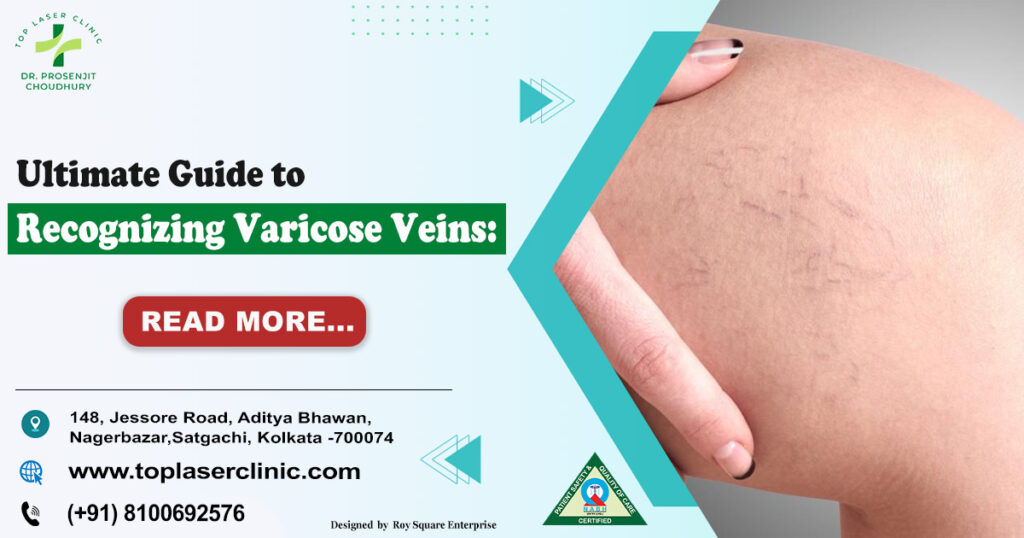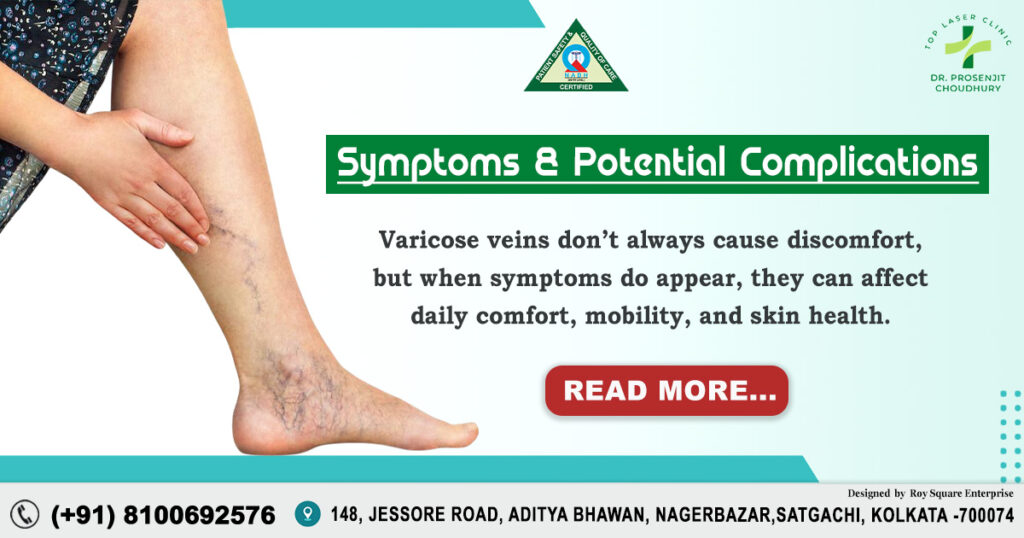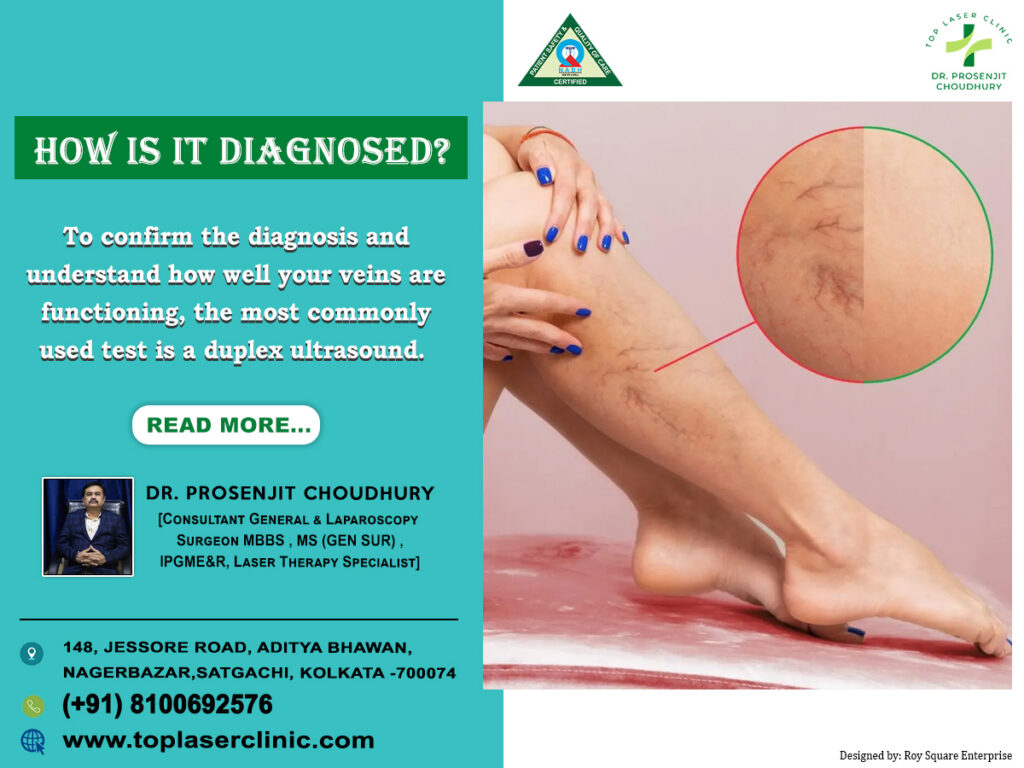
Introduction
Varicose veins are more than a cosmetic concern—they can signal vascular inefficiencies that impact comfort and mobility. In this Ultimate Guide to Recognizing Varicose Veins, we explore causes like obesity, aging, pregnancy, and heredity, and delve into symptoms, diagnosis, treatment, and recovery. Leading the way, Dr. Prosenjit Choudhury, Consultant General & Laparoscopy Surgeon | MBBS, MS (Gen Surg.), IPGME&R at Top Laser Clinic, Best general surgeon in Kolkata, renowned for his expertise in laser and minimally invasive surgery, offers authoritative insights throughout.
1. What Are Varicose Veins?
Varicose veins are enlarged, twisted superficial veins, typically seen in the legs. They result from weakened vein valves that fail to prevent backflow, causing blood pooling and vein enlargement.
Varicose veins are enlarged, swollen, twisted veins that appear just under the surface of the skin—most commonly in the legs and feet. They are often blue, purple, or dark in colour and may appear bulging or rope-like. While they can be harmless and cosmetic in some people, in others they can cause pain, discomfort, or even lead to complications.
Veins are responsible for carrying blood back to the heart. In the legs, this means fighting gravity. To help with this, veins contain one-way valves that keep blood from flowing backward. When these valves become weak or damaged, blood pools in the veins, causing them to stretch, twist, and swell—which results in varicose veins.
2. Key Risk Factors & Causes
Several factors elevate the risk of developing varicose veins:
- Valve Malfunction: Weakened or damaged valves allow backward blood flow, leading to pooling and vein enlargement.
- Genetics: A family history significantly raises risk—about half of those with varicose veins have affected relatives.
- Age: Vessel elasticity diminishes with age, weakening vein walls and valves.
- Hormonal Influence: Women are more susceptible due to hormonal shifts during puberty, pregnancy, and menopause; birth control and HRT can also contribute.
- Pregnancy: Increased blood volume, hormonal changes, and uterine pressure elevate varicose vein risk—often easing postpartum, though some cases persist.
- Obesity: Excess weight raises intra-abdominal pressure, impairing blood flow and straining vein integrity.
- Sedentary Habits or Prolonged Standing: Lack of movement or extended standing increases venous pressure, making circulation less efficient.
- Other Factors: Chronic constipation and abdominal strain may further elevate risk.

3. Symptoms & Potential Complications ( Ultimate Guide to Recognizing Varicose Veins )
Varicose veins don’t always cause discomfort, but when symptoms do appear, they can affect daily comfort, mobility, and skin health. These symptoms typically worsen after long periods of standing or sitting and may improve when the legs are elevated or during physical activity.
Many individuals experience visible, rope-like veins. Additional symptoms include:
- Leg heaviness, aching, burning, tingling or itching—especially after standing.
- Swelling, skin discoloration, rashes, or ulcers in severe cases.
- Complications may include bleeding, superficial thrombophlebitis, and non-healing sores.
4. Types of Varicose Veins
- Spider veins: Small, superficial, thread-like veins—often cosmetic.
- Reticular veins: Slightly larger and blue-green in appearance.
- Trunk varicose veins: Bulging, rope-like veins deepest under the skin—often symptomatic and the primary focus for treatment by specialists like Dr. Choudhury.

5. How Is It Diagnosed?
To confirm the diagnosis and understand how well your veins are functioning, the most commonly used test is a duplex ultrasound. This painless, non-invasive scan uses sound waves to produce real-time images of the blood flow in your veins. It helps the doctor evaluate whether the valves inside the veins are working properly and detect any blood clots or obstructions. The test also shows how blood is flowing through the superficial and deep veins, which is crucial for planning treatment—especially if laser or surgical procedures are being considered.
In more complex cases, especially where there’s suspicion of deep vein thrombosis or chronic venous insufficiency, additional imaging like CT venography or MR venography may be used. These advanced scans provide more detailed information about the deeper vascular structures.
Early and accurate diagnosis is essential to avoid complications and tailor the right treatment plan. Specialists like Dr. Prosenjit Choudhury, who is highly experienced in diagnosing and treating varicose veins using laser and minimally invasive methods, use state-of-the-art diagnostic tools to ensure a precise and personalized approach for each patient. 9Ultimate Guide to Recognizing Varicose Veins)
- Physical exam: Visual inspection and history.
- Doppler ultrasound: Evaluates blood flow and valve function to assess severity and guide therapy.
6. Treatment Options
- Conservative measures: Lifestyle advice—exercise, weight management, leg elevation, compression stockings.
- Minimally invasive interventions:
- Laser therapy and sclerotherapy—injected or laser-based techniques to close treated veins
- Surgical options: Vein stripping or phlebectomy for severe or recurrent cases.
- Why Dr. Prosenjit Choudhury? At Top laser clinic, he offers cutting-edge laser treatment for varicose veins, with benefits such as minimally invasive procedures, rapid recovery, minimal scarring, and excellent aesthetic outcomes. (Ultimate Guide to Recognizing Varicose Veins)
7. Recovery & Long-Term Outlook
Patients often resume daily life within 24–48 hours post-laser treatment. Regular follow-up, compression use, and lifestyle adherence help maintain vascular health. Recurrences can be managed with additional therapy as needed.
8. Top 10 Myth vs. Fact About Varicose Veins
| Myth | Fact |
| 1. Only cosmetic, never serious. | They can cause pain and lead to complications like ulcers. |
| 2. Only elderly people get them. | Risk increases with age but younger individuals can be affected too. |
| 3. Men don’t get varicose veins. | Both genders can get them, though risk is higher in women. |
| 4. Pregnancy-related varicose veins always go away. | Many resolve, but some persist and may need treatment. |
| 5. Compression stockings cure varicose veins permanently. | They relieve symptoms but don’t eliminate affected veins. |
| 6. Surgery is always necessary. | Many cases respond well to conservative or minimally invasive treatment. |
| 7. Exercise worsens varicose veins. | Regular movement actually improves vein health. |
| 8. Crossing legs causes varicose veins. | It doesn’t cause veins; valves and genetics are key. |
| 9. Varicose veins only affect legs. | They usually occur in legs but can appear in other areas. (Ultimate Guide to Recognizing Varicose Veins) |
| 10. Laser treatment leaves large scars. | It’s minimally invasive with minimal scarring and quick recovery. (Ultimate Guide to Recognizing Varicose Veins) |
9. Top 10 FAQs on Varicose Veins
- What symptoms should I watch for?
Observe heaviness, aching legs, visible bulging veins, or skin changes. - When should I see a doctor?
If symptoms affect day-to-day life or signs like ulcers appear, seek consultation. - Do varicose veins pose health risks?
Yes—potential complications include skin changes, ulcers, bleeding, and thrombophlebitis.( Ultimate Guide to Recognizing Varicose Veins ) - Is laser treatment effective?
Yes—minimally invasive, high success, minimal downtime (as delivered by Dr. Choudhury) - What lifestyle changes help? (Ultimate Guide to Recognizing Varicose Veins)
Maintain healthy weight, stay active, elevate legs, avoid prolonged immobility. - Can they recur after treatment?
Recurrence is possible; monitoring and early treatment help manage new veins. - Are men affected?
Yes—men do develop varicose veins, though incidence is higher in women. - Is pregnancy treatment necessary?
Many resolve postpartum; persistent cases can benefit from evaluation. - Does standing all day increase risk?
Yes—long periods of standing or sitting impair venous return and elevate risk. - Is surgery always required? (Ultimate Guide to Recognizing Varicose Veins)
No—many cases are managed with conservative or minimally invasive treatments.
Final Words
Varicose veins are common but manageable with the right knowledge and care. If you’re experiencing discomfort or visible veins and want expert, compassionate guidance, Dr. Prosenjit Choudhury, Consultant General & Laparoscopy Surgeon—with specialization in laser and minimally invasive vascular care—is an excellent choice. His approach combines advanced technology with minimal recovery time and aesthetic sensitivity,
Stay informed, act early, and reclaim your vascular health with confidence.